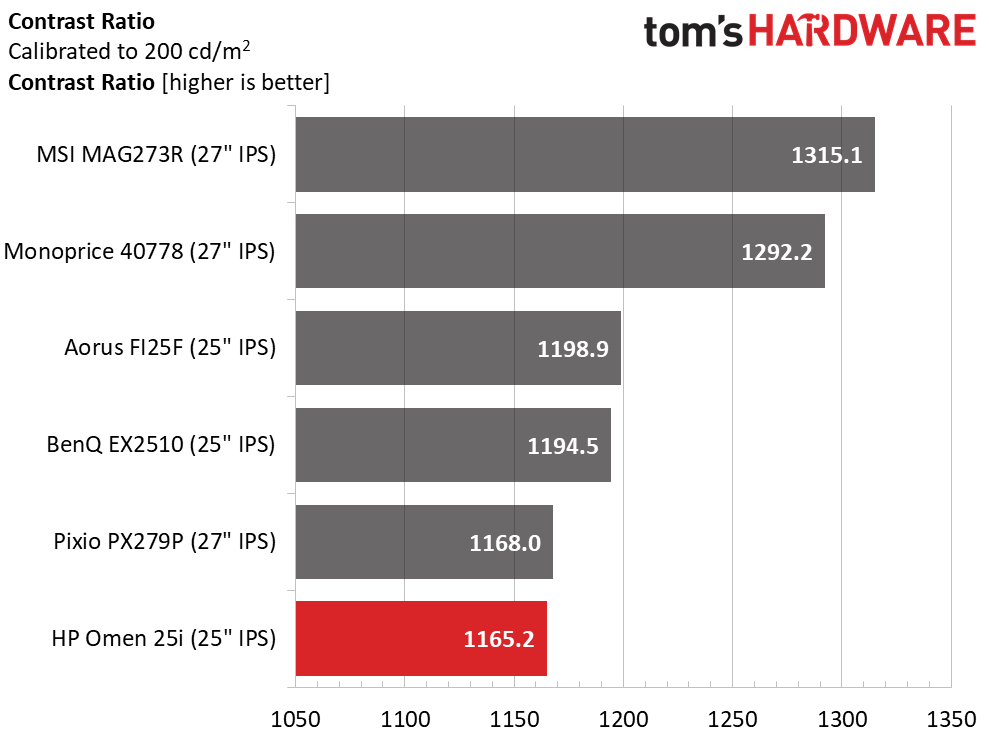Why you can trust Tom's Hardware
To read about our monitor tests in-depth, please check out Display Testing Explained: How We Test PC Monitors. We cover brightness and contrast testing on page two.
Uncalibrated – Maximum Backlight Level
It was difficult to find five other monitors that share the Omen 25i’s feature set. Most 25-inch 1080p screens run at 240 Hz but don’t include HDR or extended color. To keep the group centered around price, we added 27-inch monitors. The comparison includes the Gigabyte Aorus FI25F, Monoprice’s Dark Matter, Pixio’s PX279 Prime, BenQ’s Mobiuz EX2510 and MSI’s Optix MAG273R. All are IPS-based.



The Omen 25i has plenty of output with nearly 400 nits available for SDR content. The BenQ and MSI screens aren’t quite as bright but still have plenty of juice for any indoor environment. The OMen 25i sports respectable black levels that take its default contrast ratio to 1,204:1. This is quite good for any IPS panel, but the other monitors also operate in that range. Contrast is visually the same for all the screens here with none having a very distinct advantage.
After Calibration to 200 nits



Our calibration to 200 nits brightness (see our recommended settings on page 1) didn’t change the Omen 25i’s contrast much. But the MSI and Monoprice monitors achieved notably higher contrast numbers with calibration. There is still no major difference between the monitors overall though. One might see a little more depth from the MSI, but the HP is still comfortably above average among IPS screens in this test. You’ll also see in our next tests that the Omen 25i also has a larger color gamut than all but the MSI, which will enhance its picture quality further.
The Omen 25i’s ANSI contrast is slightly lower than the static number, due to a couple of hot spots near the bottom of our sample’s screen. It’s a minor uniformity issue; the test result is still quite good. Any IPS monitor that can achieve over 1,000:1 ANSI contrast is ahead of the curve.
Get Tom's Hardware's best news and in-depth reviews, straight to your inbox.
Current page: Brightness and Contrast
Prev Page Features and Specifications Next Page Grayscale, Gamma and Color
Christian Eberle is a Contributing Editor for Tom's Hardware US. He's a veteran reviewer of A/V equipment, specializing in monitors. Christian began his obsession with tech when he built his first PC in 1991, a 286 running DOS 3.0 at a blazing 12MHz. In 2006, he undertook training from the Imaging Science Foundation in video calibration and testing and thus started a passion for precise imaging that persists to this day. He is also a professional musician with a degree from the New England Conservatory as a classical bassoonist which he used to good effect as a performer with the West Point Army Band from 1987 to 2013. He enjoys watching movies and listening to high-end audio in his custom-built home theater and can be seen riding trails near his home on a race-ready ICE VTX recumbent trike. Christian enjoys the endless summer in Florida where he lives with his wife and Chihuahua and plays with orchestras around the state.
-
Sleepy_Hollowed This is a really interesting panel, probably my top choice for 1080p gaming (which is honestly all the rage these days for retro gaming and due to lack of GPUs).Reply
The HDR is what really sets it apart and I will be getting this if no one else releases something like this in the 1080p sphere.
I just wish it was available in 2560x1080p to play MMORPGs and shooters with more real estate, but it is what it is. -
Aequanimitas The calibration settings table seems to be badly formatted. Is it possible for it to be corrected so it is more understandable?Reply
On another note, this is for me the best 1080p IPS monitor, just wish it had a better stand, the one it comes with it´s kind of a joke.